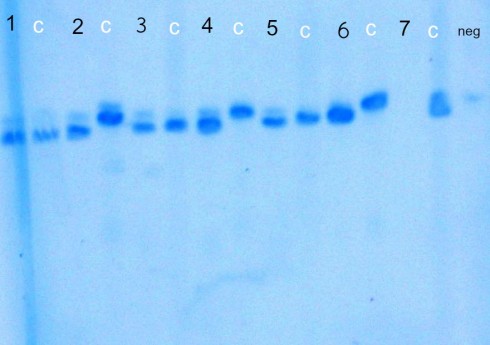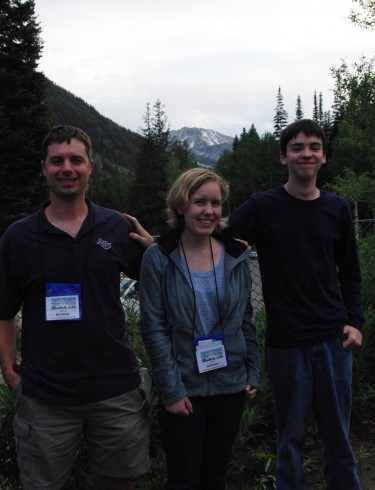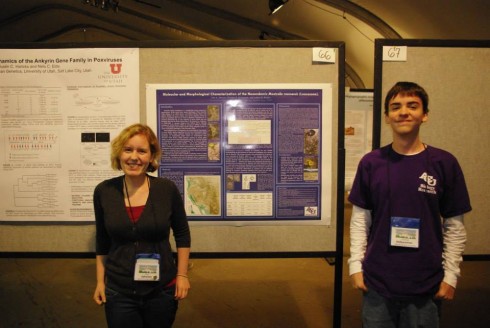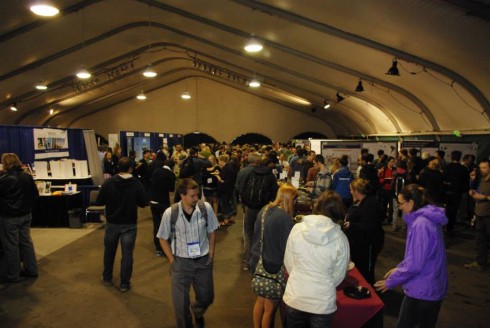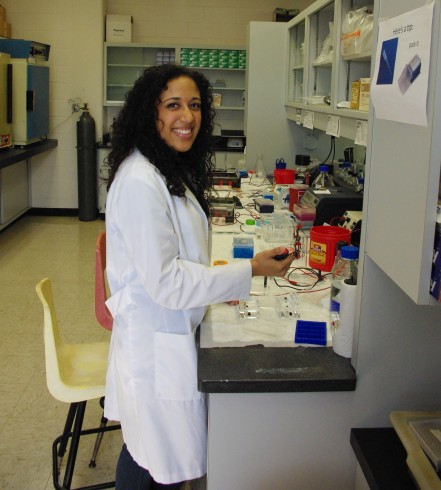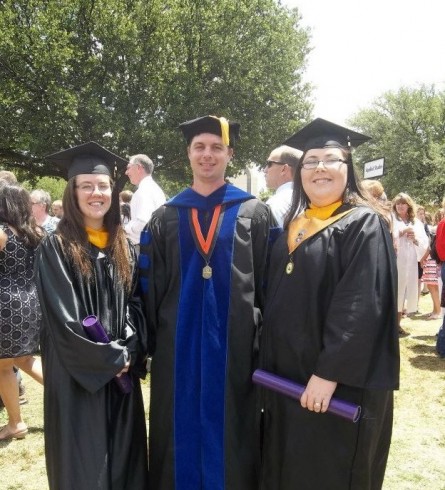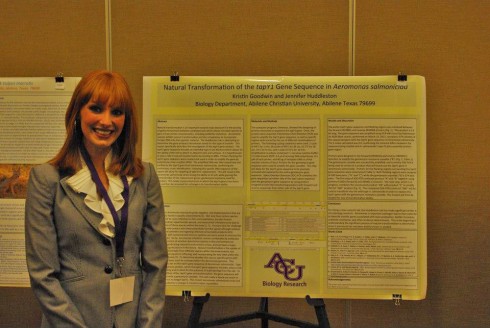Part Two: Fieldwork (With Some Additional Adventures)
So, back to our adventure! After leaving the Evolution Conference on Tuesday evening, we returned to our campsite to prepare for the proceeding days. Accordingly, the next morning we said goodbye to Snowbird and began our 10-hour journey across Utah and Nevada to Mono County, California (home of M. monoensis). Nevada was a bit barer than some of our other locales. However, as we progressed further west, we encountered some interesting landmarks—such as the Sierra Nevada. By about 10 or 11 p.m. Wednesday night, we arrived at the Twin Lakes campsite in Mammoth Lakes, California. As you could imagine, it was a bit challenging setting up our tents at night. But luckily for us, Dr. Brokaw and Christian are camping experts; our tents were set up in no time! I cannot say the same of myself (to say the least), but I did manage to provide moral support (in a manner of speaking).
Thursday through Saturday we focused primarily on fieldwork: collecting soil and plant samples throughout the Mono County area. So the next day our fieldwork adventures began! But first, after eating breakfast, we had to move to another campsite to extend our stay (as we planned to leave on Sunday or Monday). This delayed our fieldwork by a few hours or so, but we still began before noon. So, we took off in our station wagon in search of M. monoensis. Honestly, I wasn’t quite sure what fieldwork would entail. I knew what kinds of environments M. monoensis preferred to live in (disturbed sites with pumice soil), but I wasn’t quite sure how we would differentiate between species or even collect the plants themselves. Furthermore, where we would go looking for them? Luckily, Christian and I were with someone who had a lot experience collecting Mentzelia. As far finding the species was concerned, we used a GPS to return to locations that previously hosted the plants. While this wasn’t a foolproof method (especially as conditions were drier this year), we did manage to collect quite a number of samples this way. Once we arrived at a location, we parked the car and retrieved our supplies—which included brown paper bags (for soil collection), a shovel, a marker, and a plant press. Armed with supplies, we went out in search of our species. Often instead of M. monoensis, we would encounter M. albicaulis or M. congesta. But Dr. Brokaw taught Christian and I ways to better differentiate between the species. M. congesta, for instance, has distinct white bracts. Furthermore, M. monoensis has a subtle coloration difference (particularly in its leaves) compared to other species. Once we identified a plant to collect, we removed it (roots and all) from the soil. Next, we enclosed it in newspaper and preserved it in our plant press. Finally, we collected soil samples for every location. When collecting, we were often met with disappointment and did not encounter any of our plants. However, we still collected soil samples from these locations as samples were previously collected there. I soon came to realize that these disappointments were inherent to fieldwork. We never knew for certain where any specimen might be, for better or worse.
Friday and Saturday continued in a similar vein. We collected more samples—some in secluded destinations and others near crowded highways—and recorded our findings. But we did break from our scheduled routine for some recreational activities. On Friday, for instance, we had dinner at the Whoa Nellie Deli, a famous restaurant (it has its own Wikipedia page, so that tells you something!) located inside a Mobil gas station near Yosemite National Park. Now typically gas stations do not serve gourmet fare (unless you consider Subway “gourmet”), but this restaurant did, in fact, do just that. Dr. Brokaw and Christian took a break from their usual Spam sandwiches and ordered lobster tacquitos (three taquitos served on a bed of Brazilian black beans topped with tomatillo salsa and fresh salad), while I chose a veggie burger (of the Portobello Mushroom variety). While I’m no food critic by any means, the food was truly exceptional and all of us were satisfied. Our adventures for the day weren’t quite finished yet, for later that evening we collected wood and built a campfire—the quintessential camping experience, right? Again, I can’t say my efforts were truly instrumental in the campfire building process, but I digress. Saturday, too, brought with it more adventures. After completing our fieldwork, we decided to try hiking around the area. Again, I wasn’t quite sure what to expect. But let’s just say I liked the idea of hiking more than the actual hiking experience itself. Naturally, I am bit uncoordinated so our journey (particularly downhill) was a bit of challenge for me. But even so, it was really amazing to see the area from a bird’s-eye view; hiking gave me a new appreciation for it even.
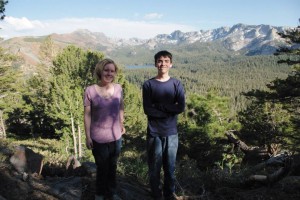
Come Sunday we decided to spend the day in Yosemite National Park. We left at a decent time, so we entered the park about mid-morning—which left us with plenty of time to explore the area. We first stopped by the Visitor Center, which gave us (Christian and me, as Dr. Brokaw had been to Yosemite before) a feel for the park. Leaving the Visitor Center, we were excited to see the amazing natural wonders, such as El Capitan and Half Dome. But—and this is where things get a little interesting—God had other plans in store for us. As we were driving through Yosemite (about 15 minutes after leaving the Visitor Center), our car started to malfunction. I should preface this by mentioning a couple of things. Throughout the trip, we had been charging a few of our accessories through the car: namely, Dr. Brokaw’s laptop and our portable refrigerator. Save for some minor difficulties, this charging system was working pretty well. In hindsight, yes, we probably could have seen it coming, but at the time our issues didn’t seem that serious. But, as evidenced, they were serious. Back to the car troubles: our car surged forward and back cyclically, our power windows stopped working, and our radio/clock completely shut off (among many other things that I don’t quite remember). As we made our way through Yosemite, other drivers were giving us weird looks and drivers behind us were frustrated. Luckily, we found a place to pull over. However, we quickly discovered that the car wouldn’t turn on and that we had to little to no cell phone service. We were stranded in Yosemite.
As we needed our car towed, we realized we were going to have to hitchhike to a payphone. So, we made a sign out of cardboard (“CAR TROUBLE. NEED RIDE.”) and waited for help. Approximately 45 seconds later, a nice couple from Denton, Texas pulled over and assisted us. They drove us 4 miles up the road to the nearest payphone; they were even nice enough to stay with us and wait. After being dropped off back at the car by the friendly Texans, we made the best of our situation and had a makeshift picnic. In all honesty, it wasn’t a bad place to be stranded—we certainly had a nice view. About 2-3 hours later, a tow truck arrived and drove us back to the Goodyear at Mammoth Lakes. Conveniently for us, Mammoth Lakes provided a free bus service; there was even a stop at our campsite! So, we hopped on a bus and headed to an affluent area known as the Village to catch a bus to our campsite. Not so conveniently for us, however, was the fact that the bus to our campsite stopped running after 5 p.m. So, we found ourselves stranded again. Luckily, Dr. Brokaw found us a nice place to stay for the night (the Alpenhof Lodge) and we “camped” in our hotel rooms for the night. Like I said, not a bad place to be stranded.

After eating a nice complementary breakfast, the next morning we took the bus to the Goodyear. But we were met with more disappointment, as we would have to wait another day for the mechanics to look at our car. But we made the best our situation and headed to the library (our new favorite hangout), continuing to exploit Mammoth Lakes’ free services. After reconnecting with civilization (thank you, Wi-Fi), we headed back to our campsite for the remainder of the day. Come Tuesday, we started to fall into a “routine,” so to speak. We headed on the buses to the Goodyear, followed by the library, and then back to the Goodyear again. Fortunately, the mechanics were able to look at our car. And we happily discovered that our stay in Mammoth Lakes would (if all things went as planned) be coming to a close the next day at noon. Though, as Dr. Brokaw put it, we were cautiously optimistic.
On Wednesday, we packed up most of our supplies and headed back to the now-familiar Goodyear. We waited, finding ways to entertain ourselves until our car was ready to pick up (such as reading magazines intended for private jet owners and whatnot). Thankfully, they were able to fix our car (the alternator was blown, if you were curious) and, by 1 p.m. or so, we drove it back to the campsite to pack up the remainder of our supplies. We were now able to leave Mammoth Lakes, California and head back to Abilene, Texas—it would just take us an additional 21 hours of driving to get there. Luckily, we weren’t too off schedule (we originally planned to return on the 4th), however Christian did have to reschedule his flight. Anyway, we had a long drive ahead of us. Again, we traveled through Nevada; however this time we went through Las Vegas and briefly visited the Hoover Dam (both very cool). I wish I could say I stayed awake throughout the entirety of our drive (like Dr. Brokaw), but alas I failed. Though a couple of hours after I fell asleep we stopped at a rest stop in Arizona for a few hours, which was beneficial for us all. After our stop, we continued our journey through the rest of Arizona, New Mexico, and finally Texas. We ended our journey in Abilene on the evening of the 4th of July.
Again, I would like to offer a few words of reflection before I put this blog post to a close. First, I want to thank Dr. Brokaw for this entire experience; I am so grateful that I was able to grow academically and spiritually as a part of this trip. It is nice to know that Christian and I have an academic mentor to guide us throughout the rest of our time at ACU. Furthermore, I think this experience allowed me to more fully appreciate my teachers—both past and present—which I am glad that I realize early on in my academic life. Additionally, after this experience, I am more aware of how I perceive myself in relation to others, which is another vital personal realization. Finally, I am glad I was able to actually experience fieldwork and interact with the plant I’ve been studying for these past 7 months. In a way, it was cathartic to visit the Mono Lake area—a place that before had only existed in articles and the like. Now, more than ever, I feel connected to what I’m studying in the lab. To reiterate my title, it was an experience of a lifetime.






